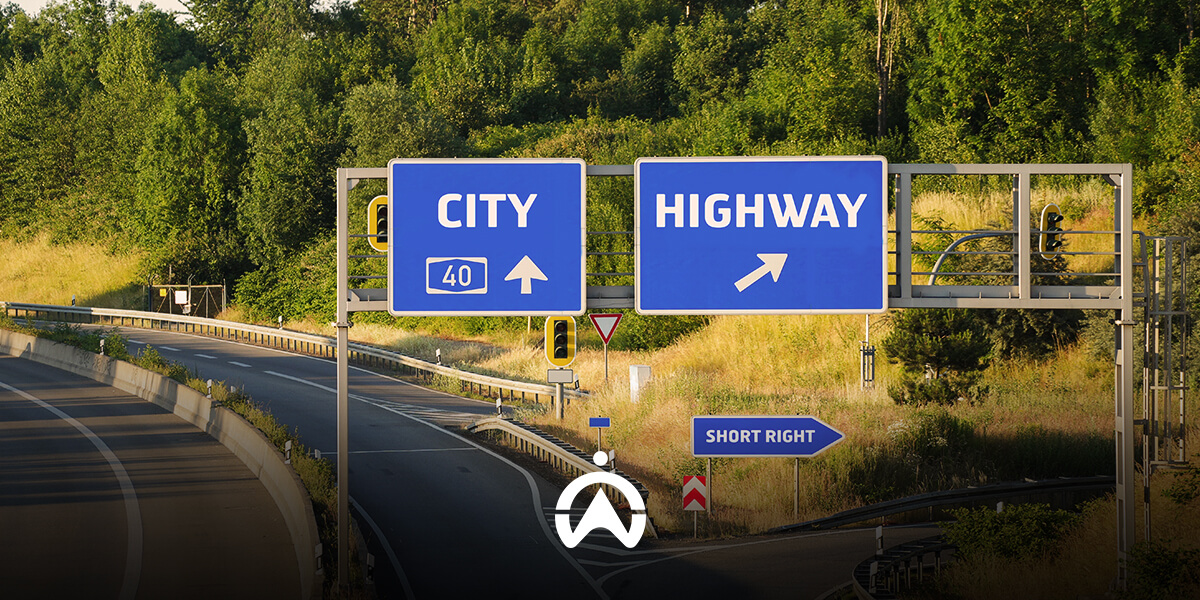- Solutions
- The Company
- About usCartrack offers smart fleet solutions guaranteed to optimise your fleet and workforce, no matter how big or small your business.
- Investor RelationsCartrack has a history of strong cash flow generation and cash conversion, low financial leverage and strong dividends.
- CareersCareers portal. View all the current Cartrack career openings and opportunities available.
- Resources
- Contact Us
- Bahasa
- Login
City Driving vs Highway: How Can You Really Save on Petrol Either Way

---- 2024/10/09 ---
Whether your daily trips involve driving through busy streets or scenic highways, both present unique challenges and affect your vehicle’s fuel consumption.
With a basic understanding of fuel consumption in both city and highway driving, useful tips for maximising your fuel efficiency and the help of Cartrack, you can significantly reduce your fleet’s fuel and maintenance costs.
Let’s start saving.
City driving vs highway: Which is more fuel efficient?
Not all roads treat your fuel tank the same.
After dispatching your fleet to deliver materials and packages via different roads, have you ever compared the fuel consumption of vehicles that drive through the city to deliver in suburban areas to those that use highways to deliver to factories and warehouses?
If you have, you’ll find that driving through urban streets causes your vehicle more strain, not just with fuel usage but wear and tear as well. Your engine works harder when navigating the streets, changing driving speeds, halting or coming to a complete stop at intersections, and so much more.
Let's see what makes these two have such an effect on your fuel efficiency:
Driving on urban streets
City driving is full of short streets split by intersections, zebra crossings, traffic lights, and more. Here are the factors that influence your fuel consumption rate.
- Stop-and-go driving: Every time you yield at a zebra crossing or slow down to drive over a speed bump, your engine exerts effort to decrease or accelerate speed, putting strain on your engine. Issues like load shedding that cause traffic lights not to work can increase the number of times you need to slow down or stop due to the traffic that can form, leading to higher fuel usage.
- Traffic lights and stop signs: When coming to a complete stop, abrupt acceleration can greatly affect your fuel consumption, as can frequently stopping at traffic lights, which causes unnecessary idling. Idling for 2 minutes can burn the same amount of fuel as driving for 1 km.
- Driver behaviour through urban infrastructure: How you drive affects how much fuel your vehicle uses. Risky driving behaviour such as harsh acceleration, sharp cornering or sudden braking can negatively impact your fuel consumption.
Driving on open highways
Open highways are easier on your tank, but there are still some downsides that affect your fuel efficiency.
- Consistent speeding over long distances: Driving at a steady pace at a moderate speed within a set highway speed limit is more fuel-efficient than constantly changing gears to speed up or slow down. Using cruise control is recommended when driving over long distances on highways to further improve fuel use.
- Vehicle weight: The weight of your vehicle plus the weight of materials of cargo you load onto your vehicle plays a role in its fuel consumption. The heavier your vehicle, the more fuel it takes to maintain highway speed. Reducing weight or using more appropriate vehicles that can withstand the extra weight can improve fuel efficiency.
- Traffic congestion during peak hours: Unfortunately, traffic congestion on highways, especially if you're driving during peak hours, can result in spending a considerable amount of time on the highway, which leads to idling and stop-and-go driving.

Impact on engine health: Which scenery is better for your engine?
Similar to how these two types of roads affect your fuel consumption, they also affect your car’s engine health. Every day, when you are faced with driving through the city or on open highways when planning a trip or route for your fleet, consider these insights for your engine.
Open roads: Driving through open roads with no traffic or heavy loads to weigh you down can positively influence your engine health. A steady speed with minimal gear adjustments or acceleration can reduce wear and tear of the engine and reduce strain on it to produce power over long highway distances.
City driving: This is where your engine works the most. City driving requires frequent acceleration and braking. This constant speeding up and slowing down can increase strain on the engine and cause significant wear and tear, especially around spark plugs and timing belts. If your vehicle frequently drives around the city, it might require a bit more TLC to continue running smoothly.
Mountain roads: These roads wind around mountains and can sometimes go off-road, which can greatly affect your engine. Climbing steep hills requires a lot of power from your engine. This terrain is usually reserved for bigger vehicles like trucks with more powerful engines, sturdy tyres, higher torque, and stronger brakes, but proper and consistent engine tuning and maintenance are still needed to help mitigate the effects of these roads.
Practicing preventative maintenance management might be your perfect solution to ensure your maintenance bills don't stack up over time due to city or hilly terrain.
Focus especially on oil changes, filter replacements, and keeping your engine clean from grime or dirt that can accumulate there.
Types of cars suitable for city vs highway driving
How can you determine which driving environment works best for your fleet? Whether your fleet consists of motorcycles or trucks, dispatching the right vehicle to a certain environment doesn't just impact fleet efficiency and operations but fuel as well.
- City driving: Compact cars, hatchbacks, SUVs, vans, and delivery motorbikes are all suitable for manoeuvring the narrow streets, frequent stopping structures and sharp corners of city driving. These vehicles are smaller in size, agile, and have smaller engines.
- Highway driving: Trucks, sedans, minivans, and bigger SUVs are vehicle types that are more suitable for highway speeds and can travel longer distances. These often have larger engines, aerodynamic designs, and comfortable cruising capabilities.
- Electric vehicles: These vehicle types can thrive in both environments. They come in different vehicle body types, have lower operational costs and produce decreased emissions.
Because of range anxiety, drivers are more comfortable using these vehicles for driving through the city as there are charging stations available or shorter highway trips due to limited charging infrastructure.
Whether urban or highway, these tips will help take you further for less
Driving the ideal vehicle types through specific areas will only get you so far in saving fuel attempts. Although this will help slow down fuel consumption, there are still extra fuel-efficient tips and tricks to reach their goals.
1. Maintain steady speed when driving and gently accelerate when needed
It's easy to maintain speed on the highway, but city streets may require you to speed up and slow down constantly. Remember, your vehicle burns more fuel when it slows down and bursts or accelerates when you hit the gas paddle from a stop.
Consider taking about 5 seconds to accelerate to 20 km per hour from a stop and then maintaining your speed from there.
2. The faster you go, the more fuel you burn
Use cruise control at a steady pace for longer on flat surface roads at the highest gear to decrease your vehicle’s fuel consumption rate.
The optimal speed for fuel efficiency in various vehicles (passenger cars, vans, pickup trucks and SUVs) is between 50 km/h and 80 km/h; any more, your vehicle’s fuel consumption rate increases.
3. Reduce idling
This is a tall order, especially when city streets and highways are jammed during peak hours. If your vehicle has not moved for more than 60 seconds while delivering packages or loading parcels onto it, it is better to switch the engine off than to stay idle.
In just 10 minutes, a 3-litre vehicle can waste up to 300 ml (more than 1 cup) of fuel while idling.
4. Use safe driving techniques when operating vehicles
How you drive a vehicle can influence how much fuel the vehicle uses. Unsafe driving habits such as speeding, harsh acceleration, and abrupt braking or cornering not only influence fuel economy but also contribute to wear and tear issues that might affect maintenance costs.
5. Don’t fall behind on your vehicle maintenance
The healthier the vehicle, the better its fuel efficiency. Following your vehicle’s maintenance schedule and regularly servicing, it ensures its performance as intended.
Believe it or not, tyre pressure also influences fuel usage. Make sure your tyres are inflated to the recommended amount by your vehicle’s manufacturer, which can be found on the edge of the driver’s seat’s doorpost.
By practising these tips, you’ll not only achieve fuel efficiency for your vehicle(s) but enjoy these benefits as well:
- Save on fuel costs
- Prevent wear and tear
- Lower carbon dioxide emissions
- Improve road safety
- Extend engine life
- Enhance vehicle performance

How Cartrack solutions improve fuel management for both environments
Cartrack is acclaimed as the best vehicle tracking system by motorists who trust its vehicle tracking and fleet management solutions.
They have an extensive line of features all ready to turn your vehicle(s) into well-oiled, optimised machines.
Here’s how Cartrack’s features can help you achieve your fuel efficiency goals no matter which roads you use.
- Fuel monitoring
With Cartrack’s CANBus and fuel sensors, managers can accurately track their fleet’s fuel consumption rate by using real-time fuel data and accurate fuel level information.
- Route optimisation through city infrastructure
Use Cartrack Delivery to navigate the city's urban streets. Delivery can optimise your task management by providing routes that are shorter in duration, consume less fuel and avoid traffic or other obstructions to efficiently complete tasks.
- Driver training with driver scorecards
Encourage fuel-efficient driving by proactively monitoring driving behaviour through Driver Scorecards and Reports. With these, you can track risky driving behaviours such as speeding, abrupt braking, harsh cornering, and even idling and use the information for training purposes.
There is no need to imagine what we can do for your fleet; see it. Partner with Cartrack today and start seeing the difference in your fleet’s fuel consumption and overall fuel costs.













 Select Countries
Select Countries